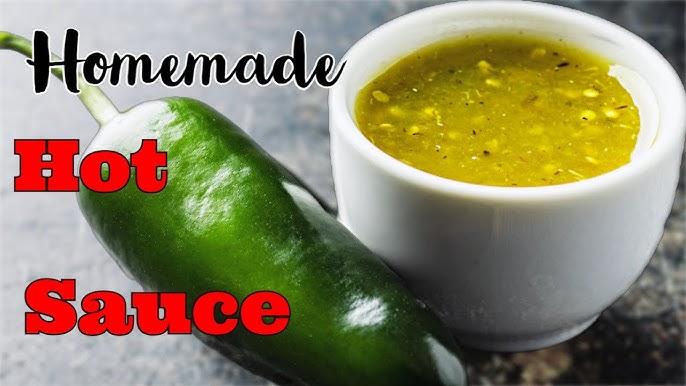Hot Sauce Recipe: Hot sauce is more than just a condiment—it’s an experience. Whether you like a subtle zing or a fiery kick, there’s something magical about making your own hot sauce at home. Why settle for store-bought when you can create a custom blend that’s tailored to your taste buds?
In this guide, we’ll walk you through everything you need to know, from selecting the perfect peppers to bottling your masterpiece.
Ingredients and Tools You Need
1. Common Ingredients for Hot Sauce
To get started, you’ll need a few basic ingredients:
- Peppers: These are the star of the show. Choose from jalapeños, habaneros, cayenne, or even ghost peppers, depending on your heat tolerance.
- Vinegar: This adds acidity and preserves your sauce. White vinegar, apple cider vinegar, or rice vinegar all work well.
- Flavor Enhancers: Garlic, onions, salt, and sugar can elevate the flavor. You can also add fruits like mangoes or pineapples for sweetness.
2. Essential Kitchen Tools
- Blender or Food Processor: For a smooth sauce.
- Gloves: To protect your hands while handling hot peppers.
- Storage Options: Glass bottles or jars with airtight lids are ideal for preserving your sauce.
Step-by-Step Guide to Making Hot Sauce
Step 1: Selecting the Right Peppers
Not all peppers are created equal. If you prefer mild heat, go for poblano or Anaheim peppers. For more heat, opt for habaneros, Scotch bonnets, or even Carolina Reapers. If you’re feeling adventurous, mix different varieties for a unique flavor profile.
Step 2: Prepping Your Ingredients
Wash your peppers thoroughly and remove the stems. If you want less heat, deseed the peppers. Chop garlic, onions, or any additional ingredients to prepare them for cooking.
Step 3: Cooking the Ingredients
In a saucepan, combine your chopped peppers, garlic, onions, and spices with a splash of vinegar. Simmer over medium heat for about 10–15 minutes, stirring occasionally. This step helps meld the flavors together.
Step 4: Blending the Mixture
Once cooled slightly, transfer the cooked mixture to a blender or food processor. Blend until smooth. If the sauce is too thick, add more vinegar or water until you reach your desired consistency.
Step 5: Storing Your Hot Sauce
Pour the hot sauce into sterilized glass bottles or jars. Seal tightly and store in the refrigerator. Your homemade hot sauce can last for weeks or even months if stored properly.
Customizing Your Hot Sauce
1. Experimenting with Heat Levels
Want to turn up the heat? Use more hot peppers or add chili flakes. For a milder version, use fewer seeds or balance the spice with a touch of sugar.
2. Adding Fruits or Sweeteners
Try blending in mangoes, peaches, or honey for a touch of sweetness. These ingredients pair especially well with hotter peppers, creating a complex flavor profile.
3. Incorporating Herbs and Spices
Fresh cilantro, basil, or smoked paprika can give your hot sauce an extra layer of depth. Don’t be afraid to get creative!
Tips for Perfecting Your Hot Sauce
- Balancing Flavors: If your sauce is too spicy, add a bit of sugar or more vinegar to balance the heat.
- Adjusting Thickness: Use a fine strainer to remove solids for a thinner sauce or leave it chunky for a rustic texture.
- Avoiding Mistakes: Always taste as you go and wear gloves to prevent pepper burns.
Health Benefits of Homemade Hot Sauce
Homemade hot sauce isn’t just delicious; it’s also good for you! Capsaicin, the compound responsible for the heat in peppers, can boost metabolism and improve circulation. Plus, homemade sauces are free of preservatives and artificial ingredients.
Serving Ideas and Pairings
Hot sauce is incredibly versatile. Drizzle it on eggs, tacos, or pizza for a spicy kick. Use it as a marinade for chicken or a dip for fries. The possibilities are endless!
FAQs about Hot Sauce Recipe
What are the basic ingredients needed to make hot sauce?
The basic ingredients for a simple hot sauce include chili peppers, vinegar, and salt. You can also add garlic, onion, or other spices to enhance the flavor.
How long does homemade hot sauce last?
Properly stored in an airtight container in the refrigerator, homemade hot sauce can last up to 90 days. Always use clean utensils when serving to help extend its shelf life.
Can I make hot sauce without vinegar?
Yes, you can use alternatives like lemon or lime juice for acidity, or ferment the chili peppers to create a natural acidity and complex flavors.
Is it necessary to cook the ingredients?
While some recipes require cooking to blend the flavors and soften the peppers, you can also make raw hot sauces by blending the ingredients and straining them as desired.
What are some tips for making hot sauce spicier?
To increase the heat level, add more hot peppers like habaneros or ghost peppers to your recipe. You can also include the seeds and membranes of the peppers for extra spice.
How can I thicken my hot sauce?
To thicken hot sauce, you can simmer it to reduce the liquid or add natural thickeners like xanthan gum or cornstarch dissolved in water.
Can I use dried peppers for making hot sauce?
Absolutely! Dried peppers can be rehydrated in warm water and then blended as part of your hot sauce. This method often introduces a smoky, intense flavor.
Conclusion
Making your own hot sauce is a fun and rewarding experience. By following this step-by-step guide, you can create a sauce that’s perfect for your taste buds. Don’t be afraid to experiment with flavors, and remember, practice makes perfect. Once you start, you’ll never want to go back to store-bought options!



